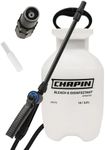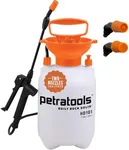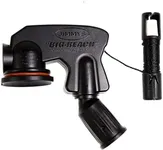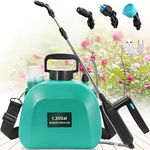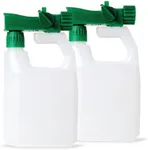Buying Guide for the Best 1 Gallon Sprayers
When choosing a 1-gallon sprayer, it's important to consider the specific needs of your gardening or cleaning tasks. A 1-gallon sprayer is a versatile tool that can be used for applying pesticides, herbicides, fertilizers, and even cleaning solutions. To ensure you select the best sprayer for your needs, you should evaluate several key specifications. Understanding these specs will help you make an informed decision and get the most out of your purchase.MaterialThe material of the sprayer is crucial because it affects durability and chemical compatibility. Common materials include plastic, stainless steel, and polyethylene. Plastic sprayers are lightweight and affordable but may not be as durable. Stainless steel sprayers are more robust and resistant to corrosion, making them ideal for heavy-duty use. Polyethylene sprayers are chemical-resistant and durable, suitable for a wide range of applications. Choose a material based on the type of chemicals you plan to use and the frequency of use.
Nozzle TypeThe nozzle type determines the spray pattern and coverage. Adjustable nozzles allow you to switch between different spray patterns, such as a fine mist or a concentrated stream, providing versatility for various tasks. Fixed nozzles offer a consistent spray pattern but may limit flexibility. Consider an adjustable nozzle if you need to perform different types of spraying tasks, while a fixed nozzle may be sufficient for single-purpose use.
Pump MechanismThe pump mechanism is responsible for pressurizing the sprayer. There are two main types: manual and battery-operated. Manual pumps require physical effort to build pressure, which can be tiring for large tasks but are generally more affordable and reliable. Battery-operated pumps offer convenience and ease of use, especially for extended spraying sessions, but they require regular charging and maintenance. Choose a pump mechanism based on the size of your tasks and your preference for manual effort versus convenience.
Pressure Relief ValveA pressure relief valve is a safety feature that prevents over-pressurization, which can cause the sprayer to malfunction or even burst. This feature is important for maintaining safe operation and prolonging the life of the sprayer. If you plan to use the sprayer frequently or with high-pressure applications, ensure it has a reliable pressure relief valve to avoid accidents and equipment damage.
Hose LengthThe hose length affects the reach and maneuverability of the sprayer. Longer hoses allow you to cover larger areas without moving the sprayer frequently, which is useful for extensive gardens or large cleaning tasks. However, longer hoses can be more cumbersome to handle and store. Shorter hoses are easier to manage and store but may require more frequent repositioning of the sprayer. Choose a hose length that matches the size of the area you need to cover and your preference for ease of use.
Ease of CleaningEase of cleaning is important for maintaining the sprayer and ensuring it functions properly over time. Sprayers with removable parts and wide openings are easier to clean, which helps prevent clogs and chemical buildup. Consider how easy it is to disassemble and clean the sprayer, especially if you plan to use it with different chemicals or solutions. A sprayer that is easy to clean will save you time and effort in the long run.


